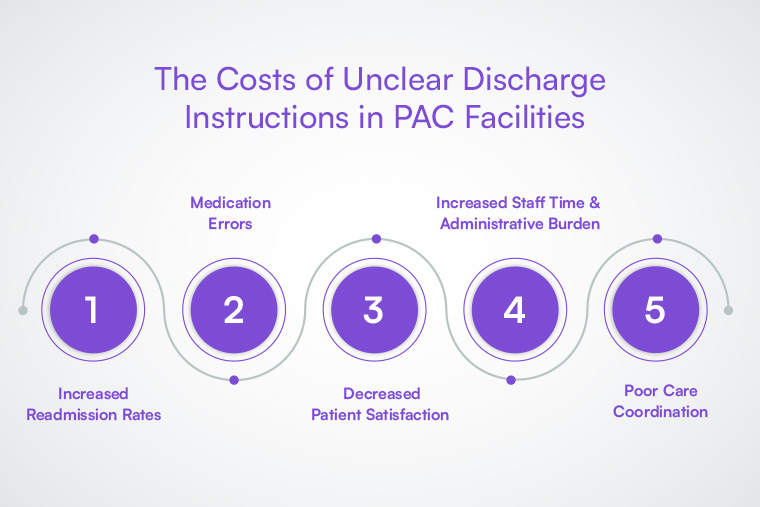1. Introduction: The Hidden Cost of Unclear Discharge Instructions in PAC Facilities
Post-acute care (PAC) facilities play a critical role in the healthcare continuum, helping patients recover after hospital stays. The goal is to ensure patients transition smoothly from intensive hospital care to lower-level care settings, where they can continue their recovery. However, one major area that frequently leads to costly issues in PAC facilities is unclear or inadequate discharge instructions.
When discharge instructions aren’t communicated properly, patients and their caregivers are left confused, which can lead to serious consequences: medication errors, missed appointments, unplanned hospital readmissions, and even worsening health conditions. For PAC facilities, this translates into higher readmission rates, increased operational costs, and diminished patient satisfaction.
In this blog, we’ll explore the cost of unclear discharge instructions in PAC facilities and provide actionable strategies to improve the discharge process and reduce costs.
2. The Costs of Unclear Discharge Instructions in PAC Facilities

Unclear discharge instructions may seem like a minor issue, but they can have significant repercussions. Here are some of the direct and indirect costs associated with unclear discharge instructions:
2.1 Increased Readmission Rates
Unclear or incomplete discharge instructions are a major contributing factor to hospital readmissions. Patients who do not fully understand their care plan or medication regimen are more likely to experience complications that lead to them being readmitted to the hospital. These readmissions not only harm patient health but also result in financial penalties for PAC facilities under value-based care models.
2.2 Medication Errors
One of the most common areas where unclear discharge instructions occur is in medication management. If patients and caregivers are confused about how, when, or why to take medications, there is a higher risk of medication errors. These errors can result in adverse reactions, worsening conditions, or hospitalizations, all of which increase the cost of care.
2.3 Decreased Patient Satisfaction
Unclear discharge instructions can lead to frustration and confusion for patients and caregivers. If the discharge process feels rushed or disorganized, patients may feel abandoned or dissatisfied with their care. Negative patient experiences often lead to lower satisfaction scores and poor reviews, which can harm a facility's reputation and impact future patient referrals.
2.4 Increased Staff Time and Administrative Burden
When discharge instructions are unclear, patients are likely to have more questions after leaving the facility. This means that staff will need to spend additional time answering follow-up calls, reviewing instructions, and addressing concerns. This not only increases administrative workload but also detracts from time that could be spent on other critical aspects of patient care.
2.5 Poor Care Coordination
Unclear discharge instructions can also lead to poor care coordination between healthcare providers. If follow-up appointments, post-discharge care, or referrals are not properly explained or arranged, it can cause delays or confusion about where the patient should go next for continued care. This can result in missed appointments, delayed treatments, or a lack of necessary resources for the patient.
3. Why Clear Discharge Instructions Are Crucial for PAC Facilities

Clear, detailed discharge instructions are essential for ensuring that patients fully understand their care plan, feel confident in managing their health, and know where to turn if they encounter any issues. Properly communicated discharge instructions can:
3.1 Empower Patients and Caregivers
Clear discharge instructions give patients and their caregivers the information they need to manage the patient’s recovery effectively. This includes instructions on medication regimens, physical therapy exercises, follow-up appointments, and any warning signs to watch for. When patients and caregivers understand what’s expected of them, they are more likely to follow the care plan and prevent complications.
3.2 Reduce Readmissions and Complications
When patients leave the facility with a clear understanding of their care instructions, they are less likely to experience complications that could lead to readmissions. By addressing issues like medication management and follow-up care upfront, PAC facilities can significantly reduce the likelihood of patients requiring additional hospital stays.
3.3 Improve Overall Health Outcomes
Clear discharge instructions ensure that patients have a seamless transition from the PAC facility to home or another care setting. This continuity of care can improve overall health outcomes and contribute to faster recovery times.
3.4 Enhance Communication Between Care Teams
Clear discharge instructions help ensure that all members of the care team—physicians, nurses, social workers, and caregivers—are on the same page regarding the patient’s care plan. This promotes better communication, reduces the chances of errors, and ensures that everyone involved in the patient’s recovery is aware of their specific needs.
4. How to Fix Unclear Discharge Instructions: Software-Driven Actionable Steps for PAC Facilities
4.1 Embed Digital Discharge Checklists in the EHR
- a. Mandatory fields & e-sign-off: Nurses must complete medication, therapy, and red-flag fields before the encounter can close.
- b. Auto-populate from chart: Pulls allergies, meds, and caregiver contacts directly from existing records—no copy-paste.
- c. Audit trail: Time-stamped completion log supports compliance and quality reviews.
4.2 Auto-Generate Plain-Language Summaries & Visual Guides
- a. Content engine: Converts clinical data to 6th-grade reading level.
- b. Multimedia add-ons: Attaches pictograms, GIF demos, or explainer videos via QR links.
- c. Dual delivery: Saves PDF to the patient portal and prints automatically for bedside review.
4.3 Push Instructions to a Patient & Caregiver Mobile App
- a. Real-time reminders: Sends medication alerts, therapy checklists, and appointment prompts.
- b. Secure 2-way chat: Logs every question and answer back to the EHR.
- c. Analytics feed: Tracks open rates and adherence to flag high-risk patients.
4.4 Automate Teach-Back to Confirm Understanding
- a. Chatbot/SMS quiz: Asks key questions (e.g., dosage timing) post-discharge.
- b. EHR write-back: Stores answers as structured data; wrong answers trigger alerts.
- c. Report dashboard: Displays comprehension scores by unit, shift, and diagnosis.
4.5 One-Click Follow-Up Scheduling & Sync
- a. API scheduler: Books outpatient or tele-rehab visits before the patient leaves.
- b. Calendar integration: Sends invites with map links/video URLs to app and email.
- c. Unified timeline: Writes appointment data to the EHR so every provider sees the same plan.
4.6 Post-Discharge Monitoring with Real-Time Alerts
- a. Device & survey feeds: Streams vitals and daily symptom check-ins to a nurse dashboard.
- b. Threshold rules: Auto-alerts staff for BP spikes, pain scores, or missed meds.
- c. Continuous-improvement loop: Dashboards track alert frequency, response times, and 30-day readmissions to refine workflows.
5. The Impact of Clear Discharge Instructions on PAC Facility Operations
Clear discharge instructions are not just beneficial for patients—they also lead to significant operational improvements within PAC facilities. Here’s how:
5.1 Reduced Administrative Burden
When discharge instructions are clear and effective, patients and caregivers require less follow-up support. This reduces the administrative burden on staff, allowing them to focus on other aspects of patient care.
5.2 Improved Patient Flow
By reducing the likelihood of readmissions and complications, clear discharge instructions ensure smoother patient flow within PAC facilities. This helps optimize bed utilization and enhances overall facility efficiency.
5.3 Enhanced Patient Satisfaction
Patients who receive clear and thorough discharge instructions are more likely to feel satisfied with their care. High patient satisfaction leads to better patient retention, positive reviews, and improved referrals.
6. Conclusion: Why Clear Discharge Instructions Are Essential for PAC Facility Success

Unclear discharge instructions may seem like a small issue, but they can have wide-reaching consequences. From increased readmissions to lower patient satisfaction, unclear instructions contribute to inefficiencies that ultimately harm both patients and PAC facilities. However, by implementing standardized, easy-to-understand discharge instructions, PAC facilities can reduce costs, improve care continuity, and enhance patient outcomes.
At Cabot Technology Solutions, we specialize in helping PAC facilities optimize their discharge processes through integrated healthcare solutions. Our EHR integration, patient engagement platforms, and cloud-based solutions can help ensure that discharge instructions are clear, accessible, and effective.
If your PAC facility is ready to improve discharge planning and reduce the costs of unclear discharge instructions, contact Cabot Technology Solutions today. We offer customized solutions that streamline discharge workflows, enhance patient understanding, and improve overall outcomes.

